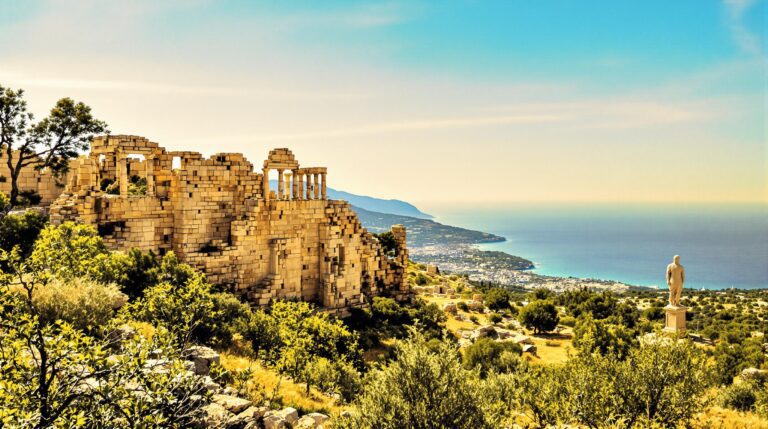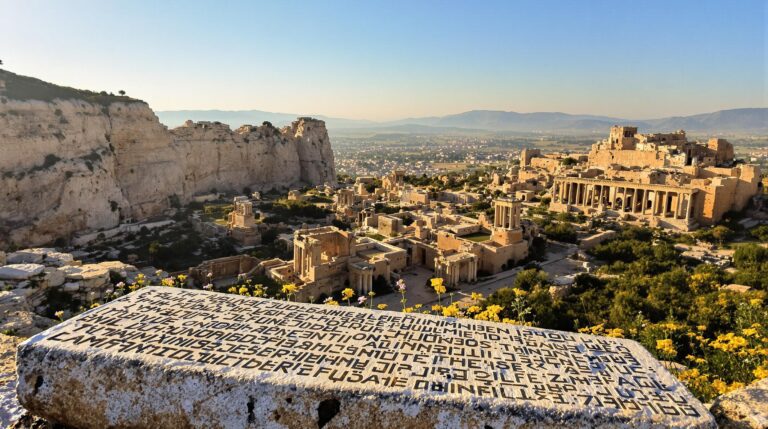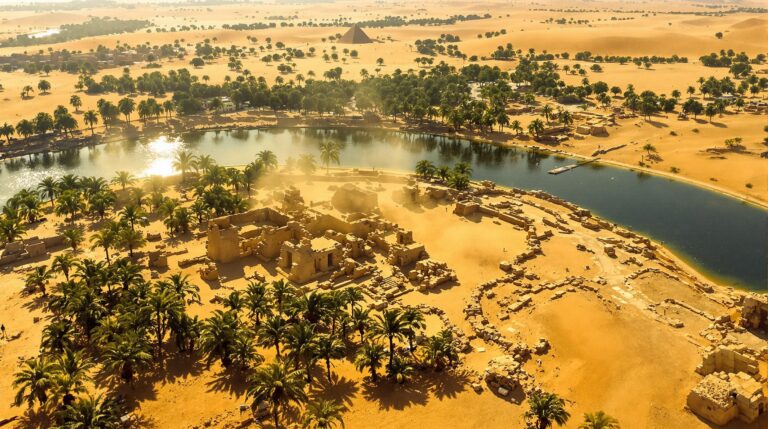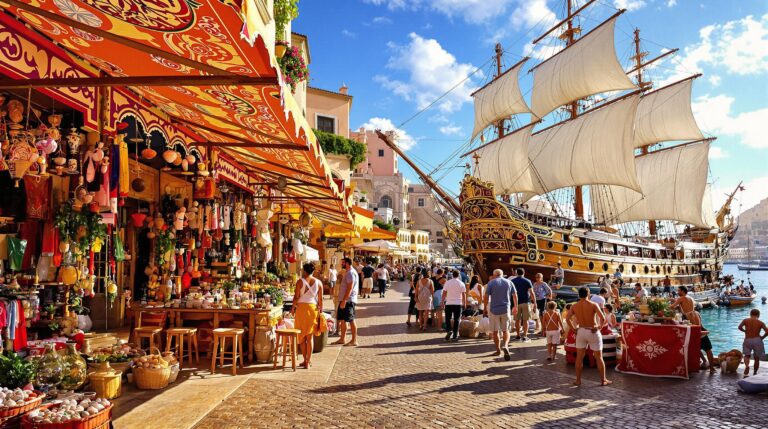Etruscan Civilization: Secrets of the Etruscans Uncovered
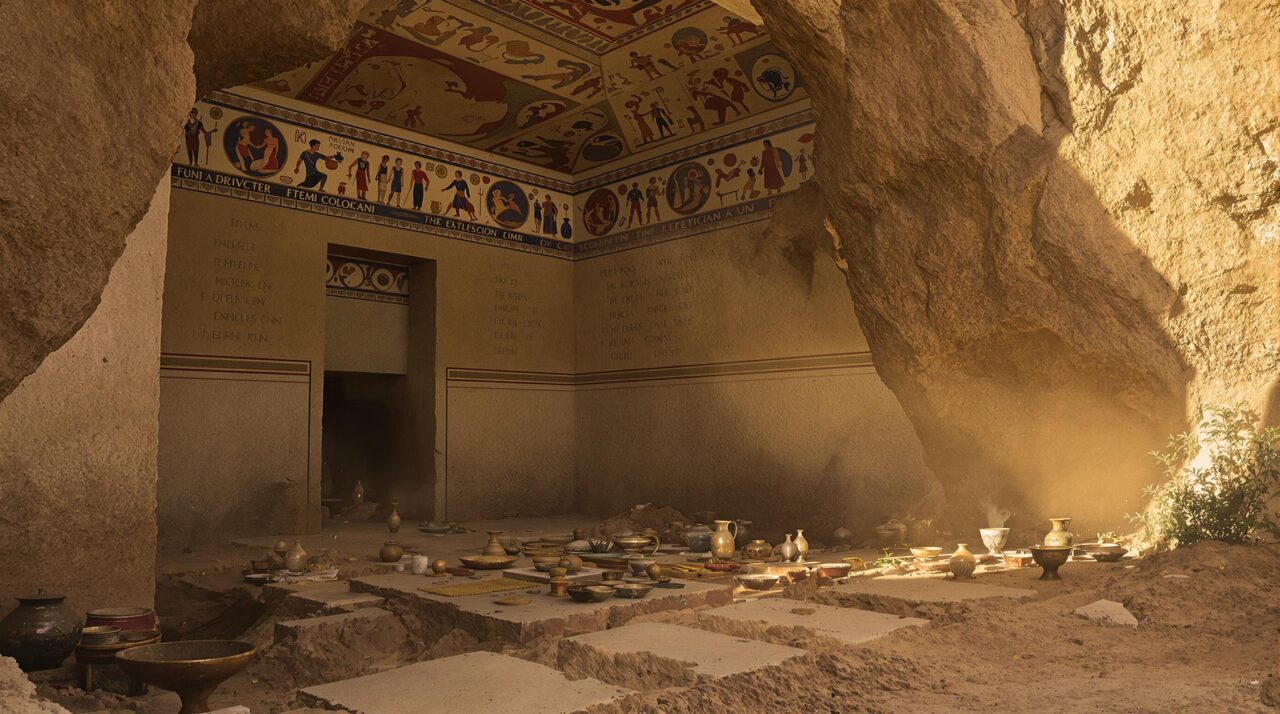
The Etruscan civilization presents a fascinating puzzle for historians and archaeologists alike.
Their origins spark debate, with theories ranging from foreign migration to indigenous development.
The Etruscan language, largely undeciphered, adds another layer of intrigue.
Additionally, their rich artistic expressions and complex burial practices hint at a society with deep beliefs and social hierarchies.
Yet, many questions linger, inviting exploration into their interactions with early Rome and the enduring mysteries that define their legacy.
Summary & Key Takeaways
Hide- The origins of the Etruscans remain debated, with theories of migration from Lydia and indigenous development both presenting compelling arguments.
- Etruscan language is largely isolated, complicating our understanding of their culture and limiting insights into their societal dynamics.
- Burial practices and vibrant tomb art reflect Etruscan beliefs about the afterlife, showcasing societal structures and cultural values.
- The Etruscan League's trade connections facilitated cultural exchanges, enhancing their economic power and influence in the Mediterranean.
- Etruscan civilization gradually declined due to political fragmentation and assimilation into Roman culture, obscuring many cultural nuances.
Origins of the Etruscans: Who Were They?
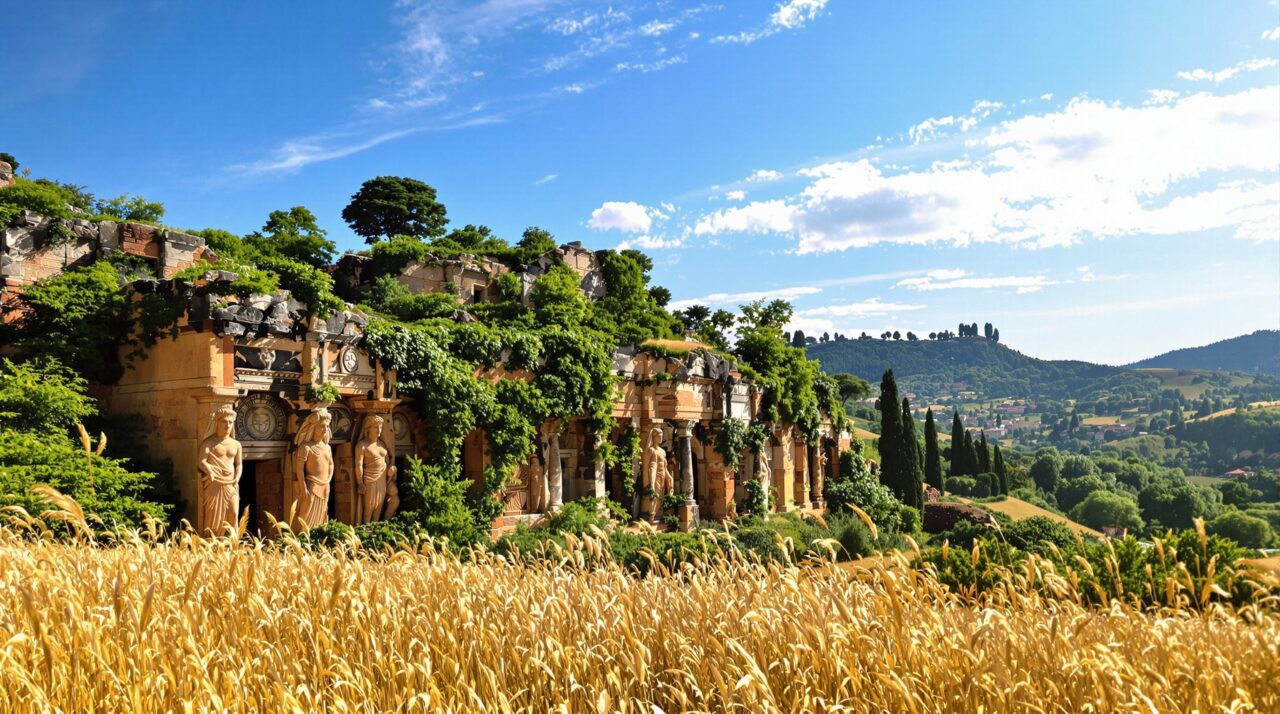
The origins of the Etruscans have long puzzled historians and archaeologists alike, prompting various theories about their ancestry.
Genetic studies and linguistic evidence offer tantalizing clues, yet the precise roots of this enigmatic civilization remain elusive.
What narratives emerge when one examines the interplay of ancient myths and modern science in understanding who the Etruscans truly were?
Ancient Theories About Their Ancestry
The origins of the Etruscans have long intrigued scholars, leading to divergent theories about their ancestry.
Herodotus proposed a Lydian migration theory, suggesting a connection to the ancient peoples of Lydia, while others advocate for an indigenous development hypothesis that posits the Etruscans as a native civilization.
These contrasting viewpoints invite further exploration into the complex identity of a society that has left an indelible mark on history.
Herodotus and the Lydian Migration Theory
Although the origins of the Etruscans have long puzzled historians, one prominent theory put forth by the ancient Greek historian Herodotus links their ancestry to a migration from Lydia in western Anatolia.
This hypothesis raises intriguing questions about cultural exchange, identity, and the movement of people.
Did the Etruscans carry with them their heritage, or did they adapt to new environments?
Indigenous Development Hypothesis
Many scholars have posited the Indigenous Development Hypothesis as a compelling alternative to migration theories regarding the origins of the Etruscans.
This perspective suggests that the Etruscans evolved from local populations, influenced by native Italic cultures.
Genetic and Linguistic Clues
Recent DNA studies on Etruscan remains have sparked new inquiries into the genetic heritage of this enigmatic civilization.
Alongside this, the isolated nature of their language presents a compelling puzzle, as it bears little resemblance to neighboring tongues.
Together, these clues invite exploration into the true origins and identity of the Etruscans, challenging long-held assumptions about their place in history.
Recent DNA Studies on Etruscan Remains
As researchers explore the enigmatic past of the Etruscans, DNA studies have emerged as a pivotal tool in unraveling the complexities of their origins.
These genetic analyses provide insights into population dynamics, revealing connections to both ancient and modern groups.
Such findings challenge long-held beliefs and invite a deeper examination of identity, migration, and the intricate tapestry of Etruscan heritage, sparking a renewed quest for understanding.
The Isolated Nature of Their Language
The exploration of Etruscan identity extends beyond genetic links, revealing a fascinating linguistic landscape that remains largely isolated from surrounding languages.
Etruscan, with its unique script and vocabulary, defies straightforward classification, prompting questions about its origins and connections.
This enigmatic language invites investigation into how culture, trade, and migration shaped its development, underscoring the complexities of ancient communication and identity within the Mediterranean world.
The Enigmatic Etruscan Language
The Etruscan language remains a source of intrigue, as its script continues to baffle scholars despite numerous surviving inscriptions and funerary texts.
These artifacts not only reflect the rich culture of the Etruscans but also pose significant challenges to linguistic interpretation.
What secrets might be hidden within these enigmatic writings, and why does the language resist full comprehension?
Why Their Script Still Puzzles Scholars
The Etruscan language presents an intriguing puzzle for scholars, primarily due to its partially deciphered alphabet juxtaposed with a vast array of undeciphered vocabulary.
The scarcity of long texts and bilingual inscriptions further complicates efforts to reveal its mysteries, leaving researchers to ponder the cultural and historical implications of this enigmatic script.
As the quest for understanding continues, the question remains: what secrets does the Etruscan language still conceal?
Deciphered Alphabet, Undeciphered Vocabulary
Though scholars have made strides in deciphering the Etruscan alphabet, the language remains shrouded in mystery due to its largely undeciphered vocabulary.
The juxtaposition of recognizable symbols against an elusive lexicon sparks curiosity. What thoughts and expressions lay hidden within these ancient inscriptions?
This conundrum compels linguists to explore further, seeking the key to reveal the Etruscan narrative, yearning for understanding.
Lack of Long Texts and Bilingual Inscriptions
While scholars have made significant progress in unraveling the Etruscan alphabet, the absence of lengthy texts and bilingual inscriptions poses a formidable barrier to fully understanding this ancient language.
The scarcity of substantial written records leaves gaps in comprehension, fostering an air of mystery. Without richer contexts, the nuances of Etruscan thought and culture remain tantalizingly elusive, inviting deeper exploration and inquiry.
Surviving Inscriptions and Funerary Texts
Surviving inscriptions and funerary texts offer a tantalizing glimpse into the Etruscan language, yet their meanings remain elusive.
Scholars have initiated a complex journey to reconstruct the grammar and semantics embedded within these ancient writings, revealing both insights and ambiguities.
What can these enigmatic texts tell us about Etruscan beliefs and societal structures, and how do they challenge our understanding of language itself?
What Has Been Learned From Tomb Writings
As scholars explore the tomb writings of the Etruscan civilization, a fascinating tapestry of language and culture begins to unfold.
These inscriptions reveal insights into Etruscan beliefs, social structures, and daily life. The texts, often poetic and enigmatic, challenge researchers to decipher not only the words but also the cultural nuances embedded within, offering glimpses into a civilization rich with mystery and depth.
Efforts to Reconstruct Grammar and Meaning
Deciphering the enigmatic Etruscan language has become a fascinating challenge for linguists and historians alike. Scholars meticulously analyze surviving inscriptions and funerary texts, seeking patterns and grammatical structures.
Each fragment offers tantalizing clues, yet the absence of a Rosetta Stone complicates understanding. As they navigate this linguistic labyrinth, the quest for meaning reveals not just words, but the essence of a lost civilization yearning for expression.
Art, Architecture, and Daily Life
The intricate burial practices and vividly painted tombs of the Etruscans reveal a complex relationship with death and the afterlife, prompting questions about their cultural values and beliefs.
Meanwhile, the layout of Etruscan cities showcases advanced urban planning that reflects societal organization and priorities.
Together, these elements of art and architecture provide a window into the daily life of a civilization shrouded in mystery.
Burial Practices and Painted Tombs
The necropolises of the Etruscans stand as intriguing portals into their societal structures and beliefs.
Each painted tomb, rich with lively imagery and symbolism, offers clues about daily life, social hierarchy, and the afterlife.
What can the intricate designs and burial practices reveal about the values and aspirations of this enigmatic civilization?
Necropolises as a Window Into Society
While exploring the colorful mosaic of Etruscan civilization, necropolises emerge as profound repositories of cultural insight, revealing the intricate interplay between art, architecture, and daily life.
The tombs offer glimpses into:
- Social hierarchies through burial goods
- Artistic expressions in frescoes
- Architectural innovations in tomb design
- Daily life reflections through funerary items
Thus, these sites illuminate the values and beliefs of Etruscan society.
Symbolism Found in Funerary Art
Etruscan funerary art serves as a vivid canvas, rich with symbolism that reveals the complexities of their beliefs and societal norms.
Each painted tomb and ornate artifact reflects a deep reverence for the afterlife, illustrating themes of continuity and transformation.
Iconography, such as dancers and banquets, suggests a celebration of life beyond death, inviting contemplation of existence, freedom, and the eternal journey of the soul.
Etruscan Cities and Urban Planning
Etruscan cities, often characterized by their robust walls and strategic layouts, reveal much about the civilization’s approach to urban planning.
How did these fortified settlements influence the architectural principles that later shaped Roman cities?
The examination of Etruscan urban design offers a fascinating glimpse into the everyday lives of its inhabitants and the enduring legacy they left behind.
Features of Their Walled Settlements
Walled settlements of the Etruscans reveal a complex interplay of art, architecture, and daily life that shaped their urban landscape.
- Thick stone walls provided defense while symbolizing communal strength.
- Centrally located temples reflected religious devotion and civic pride.
- Narrow streets facilitated social interaction and trade.
- Residential areas showcased intricate frescoes, revealing cultural values and aesthetics.
Such features invite contemplation on Etruscan identity and societal structure.
Influence on Later Roman Architecture
Although the architectural achievements of the Etruscans may often be overshadowed by those of their Roman successors, their influence on later Roman architecture is both profound and enduring.
The Etruscans introduced innovative techniques, such as the arch and vault, which shaped Roman structural design. Their urban planning principles, emphasizing public spaces and civic engagement, laid the groundwork for Rome’s monumental landscapes and communal life.
Religion and Belief Systems
The Etruscan civilization, shrouded in enigma, reveals a complex tapestry of religious beliefs centered around a pantheon of gods and spirits that governed both the natural and supernatural domains.
Central to their spiritual life were the augurs and haruspices, whose interpretations of omens and sacrifices shaped societal decisions and personal fates.
This interplay between divine influence and human agency invites a closer examination of how Etruscans perceived the afterlife and their relationship with the divine.
Gods, Spirits, and the Afterlife
The Etruscan worldview is marked by a pantheon of deities that reflects their unique cultural identity and spiritual beliefs.
Central to their religious practices was a pronounced emphasis on divination and the interpretation of omens, suggesting a society deeply attuned to the unseen forces that governed their lives.
What can these distinct elements reveal about the Etruscans’ understanding of existence and the afterlife?
Deities Unique to the Etruscan Worldview
As one investigates the intricate tapestry of the Etruscan civilization, the distinct pantheon of deities reveals a profound connection between their spiritual beliefs and daily life.
Notable deities include:
- Tinia – the chief god, associated with the sky.
- Uni – a goddess of love and war.
- Menrva – embodying wisdom and strategic warfare.
- Aplu – the god of light and healing.
These entities shaped Etruscan existence.
Emphasis on Divination and Omens
While the Etruscans held a diverse array of gods and spirits in their belief system, it was their emphasis on divination and omens that truly defined their interactions with the divine.
This practice encompassed various methods, such as haruspicy and augury, through which they sought guidance and insight.
Such rituals revealed a profound yearning to decipher the universe’s mysteries and align their destinies with cosmic forces.
Role of Augurs and Haruspices
The Etruscan civilization relied heavily on augurs and haruspices to interpret the will of the divine, utilizing techniques such as examining the skies and analyzing animal entrails.
These practices not only provided spiritual guidance but also played an essential role in the governance of Etruscan society, intertwining religious beliefs with political decision-making.
How did these rituals shape the cultural landscape and influence the authority of leaders in this enigmatic civilization?
Reading the Sky and Animal Entrails
In the intricate tapestry of Etruscan religion, augurs and haruspices emerged as pivotal figures, wielding the power to decode the messages of the divine through the natural world.
Their practices involved:
- Observing celestial phenomena.
- Analyzing animal entrails.
- Interpreting omens and signs.
- Guiding communal decision-making.
These methods reflected a profound connection between the Etruscans and their belief in the cosmos as a source of divine insight.
Integration of Religion Into Governance
Augurs and haruspices not only interpreted celestial signs and animal entrails but also played a significant role in shaping Etruscan governance.
Their insights guided decisions on warfare, agriculture, and public policy, intertwining spiritual beliefs with political authority.
This integration raises questions about the nature of power and the extent to which divine will influenced human affairs in a civilization aiming for autonomy and understanding.
Trade, Power, and Expansion
The intricate web of trade connections between the Etruscans, Greece, and Carthage raises questions about the economic and political motivations behind their alliances.
As the Etruscan League emerged, what strategies might they have employed to consolidate power and expand their influence across the Mediterranean?
Understanding these dynamics offers a glimpse into how commerce shaped the trajectory of a civilization often shrouded in mystery.
Connections With Greece, Carthage, and Beyond
The Etruscan civilization‘s intricate web of trade with Greece and Carthage raises compelling questions about their cultural exchanges and economic strategies.
The importation of exquisite pottery and metalwork alongside the export of iron and uniquely crafted goods from Etruria suggests a dynamic interplay of influence and power.
How did these connections shape their societal development and legacy in the broader Mediterranean context?
Import of Pottery, Metalwork, and Luxury Goods
Importing pottery, metalwork, and luxury goods played a pivotal role in shaping the Etruscan civilization’s economy and cultural identity.
This influx fostered connections and reflections of wealth, art, and innovation, offering insights into their society.
- Greek pottery, showcasing exquisite craftsmanship
- Carthaginian metalwork, symbolizing power
- Eastern luxury textiles, enhancing status
- Mediterranean spices, enriching culinary experiences
Export of Iron and Crafts From Etruria
Etruria’s robust export of iron and crafts greatly influenced trade dynamics and power structures across the Mediterranean.
This flourishing exchange not only enhanced Etruscan wealth but also facilitated connections with prominent civilizations such as Greece and Carthage.
The allure of Etruscan craftsmanship and ironwork sparked curiosity and competition, raising questions about cultural exchange, economic strategies, and the broader implications of Etruscan expansion in the ancient world.
Rise of the Etruscan League
The ascent of the Etruscan League marked a pivotal moment in the intricate tapestry of Mediterranean power dynamics.
As a confederation of city-states, the League not only expanded its territorial reach but also developed a formidable naval strength that facilitated trade and military prowess.
What drove this remarkable unification, and how did it shape the Etruscans’ influence in the ancient world?
Confederation of City-States
Although often overshadowed by their more famous Roman successors, the Etruscans forged a remarkable confederation of city-states that greatly influenced the cultural and political landscape of ancient Italy.
This alliance catalyzed their:
- Economic prosperity through trade networks
- Collective military strength against invasions
- Shared cultural practices and religious beliefs
- Political cohesion fostering stability and growth
Such unity propelled their prominence in the region.
Territorial Reach and Naval Strength
Emerging from the strength of their city-state confederation, the Etruscans expanded their influence across the Italian peninsula and beyond through a combination of strategic territorial reach and formidable naval power.
Their mastery of trade routes and maritime capabilities fostered not only economic prosperity but also a cultural exchange that enriched their society.
What drove this ambition for expansion, and how did it shape their legacy?
Interaction With Early Rome
The interaction between the Etruscan civilization and early Rome raises intriguing questions about cultural exchange and influence. As the Etruscans shaped various aspects of Roman life, from religious practices to architectural styles, one wonders how this relationship evolved into dominance and eventual decline.
What factors contributed to the Etruscans’ waning power as Rome ascended, culminating in their conquest and the transformation of the Italian landscape?
Cultural Influence on the Roman Kingdom
The intricate tapestry of Etruscan influence on early Rome raises intriguing questions about the foundations of Roman identity.
How did the rituals, symbols, and engineering marvels introduced by Etruscan rulers shape the burgeoning kingdom?
This exploration invites a closer examination of the lasting legacy that these interactions left on Roman culture and governance.
Etruscan Rulers of Rome and Their Legacy
How did the enigmatic Etruscan civilization shape the early foundations of Rome? Their rulers markedly influenced Roman governance and culture by:
- Establishing a centralized authority model.
- Introducing urban planning principles.
- Promoting trade networks, enhancing economic prosperity.
- Inspiring religious and artistic traditions.
These contributions left an indelible mark, crafting a legacy that would resonate throughout Roman history and beyond.
Adoption of Rituals, Symbols, and Engineering
Etruscan influences permeated various aspects of early Roman society, particularly through the adoption of rituals, symbols, and engineering practices.
The intertwining of Etruscan religious customs with Roman ceremonies illustrated a cultural amalgamation, while architectural innovations, such as the arch and drainage systems, showcased Etruscan engineering prowess.
This exchange not only enriched Roman identity but also laid foundational elements for future urban development and governance.
Gradual Decline and Roman Conquest
As the Etruscan civilization encountered the burgeoning power of Rome, a complex interplay of cultural assimilation and military conquest began to unfold.
What factors contributed to the Etruscans’ gradual absorption into Roman society, and how did this transformation affect their rich heritage?
Examining the elements that were lost alongside those that endured provides insight into the nuanced legacy of this enigmatic civilization.
Factors That Led to Their Absorption
While the Etruscans once thrived as a formidable civilization in ancient Italy, a confluence of internal strife and external pressures gradually led to their assimilation into the burgeoning Roman state.
Key factors included:
- Political fragmentation among Etruscan city-states
- Economic competition with Rome
- Military defeats in conflicts
- Cultural integration through trade and intermarriage
These elements collectively diminished Etruscan autonomy.
What Was Lost and What Remained
The gradual decline of Etruscan civilization, marked by the encroachment of Roman power, evokes a sense of profound transformation.
What remnants of their rich culture survived the Roman conquest? Artifacts, tombs, and language fragments hint at a lively identity lost to time.
Yet, elements of Etruscan influence persisted, subtly woven into the fabric of Roman society, challenging the narrative of complete erasure.
What Remains Mysterious Today
Despite significant scholarly efforts, the Etruscan civilization still harbors numerous enigmas, particularly regarding the gaps in the historical record that obscure its cultural nuances.
Ongoing archaeological discoveries frequently challenge existing assumptions, revealing artifacts and sites that prompt further questions about Etruscan life and their interactions with neighboring cultures.
What secrets lie buried beneath the soil of ancient Etruria, waiting to reshape our understanding of this enigmatic society?
Gaps in the Historical Record
The Etruscan civilization presents a tantalizing enigma, particularly in its striking absence of literature that might illuminate its cultural and philosophical landscape.
Furthermore, the elusive details surrounding their social structure leave scholars questioning the intricacies of their societal organization.
What accounts for these gaps, and how do they shape our understanding of a civilization that profoundly influenced its contemporaries?
Absence of Etruscan Literature
How did a civilization as rich and influential as the Etruscans leave behind so little literary evidence? The absence of Etruscan literature poses intriguing questions, including:
- Did societal norms prioritize oral traditions over written forms?
- Were texts destroyed or lost due to historical upheavals?
- Did the Etruscans lack a unified language for extensive writing?
- How did their eventual assimilation into Roman culture affect their literary legacy?
Missing Details About Social Structure
While the lack of Etruscan literary evidence raises questions about their cultural priorities, it simultaneously underscores the challenges faced in understanding their social structure.
How were roles defined within their society? What hierarchies existed beyond the elite classes?
These gaps create a tantalizing puzzle, inviting scholars to explore archaeological findings, art, and burial practices for insights into a civilization that remains enigmatic and richly complex.
Ongoing Archaeological Discoveries
Recent discoveries of new tombs and artifacts continue to reshape our understanding of Etruscan civilization, revealing layers of culture that remain tantalizingly elusive.
Advanced technologies are now unearthing buried sites that had long been forgotten, prompting questions about what additional secrets lie beneath the surface.
As archaeologists sift through these findings, the mysteries of the Etruscans remain as enthralling as ever, beckoning further exploration.
New Tombs and Artifacts Still Being Found
Countless tombs and artifacts continue to emerge from the earth, revealing the enigmatic legacy of the Etruscan civilization.
Each discovery invites deeper inquiry into their culture and beliefs, as researchers analyze:
- Elaborate frescoes depicting mythological scenes
- Intricately crafted jewelry showcasing artisan skills
- Unique burial practices that hint at spiritual beliefs
- Everyday items that illuminate daily life and social structure
What secrets lie within these finds?
Technologies Bringing Buried Sites to Light
As advancements in technology continue to evolve, they reveal the hidden narratives of the Etruscan civilization buried beneath layers of time.
Ground-penetrating radar and 3D imaging unearth forgotten sites, challenging past interpretations.
Each discovery ignites curiosity, prompting questions about Etruscan social structures and cultural practices.
What stories lie in the shadows, waiting for modern tools to illuminate their ancient wisdom?
Wrapping Up
The Etruscan civilization, with its intricate tapestry of language, art, and social customs, continues to captivate scholars and enthusiasts alike.
As archaeologists unearth tombs adorned with lively frescoes, such as the famed Tomb of the Diver, they reveal glimpses into a society rich in beliefs and practices.
Yet, the fundamental questions of their origins and identity linger, inviting deeper exploration and reflection on how this enigmatic culture shaped the foundations of ancient Italy and beyond.

